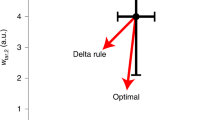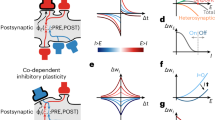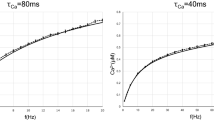Abstract
The trajectory of the somatic membrane potential of a cortical neuron exactly reflects the computations performed on its afferent inputs. However, the spikes of such a neuron are a very low-dimensional and discrete projection of this continually evolving signal. We explored the possibility that the neuron′s efferent synapses perform the critical computational step of estimating the membrane potential trajectory from the spikes. We found that short-term changes in synaptic efficacy can be interpreted as implementing an optimal estimator of this trajectory. Short-term depression arose when presynaptic spiking was sufficiently intense as to reduce the uncertainty associated with the estimate; short-term facilitation reflected structural features of the statistics of the presynaptic neuron such as up and down states. Our analysis provides a unifying account of a powerful, but puzzling, form of plasticity.
This is a preview of subscription content, access via your institution
Access options
Subscribe to this journal
Receive 12 print issues and online access
$209.00 per year
only $17.42 per issue
Buy this article
- Purchase on Springer Link
- Instant access to full article PDF
Prices may be subject to local taxes which are calculated during checkout




Similar content being viewed by others
References
Markram, H., Wu, Y. & Tosdyks, M. Differential signaling via the same axon of neocortical pyramidal neurons. Proc. Natl. Acad. Sci. USA 95, 5323–5328 (1998).
Zucker, R.S. & Regehr, W.G. Short-term synaptic plasticity. Annu. Rev. Physiol. 64, 355–405 (2002).
Abbott, L.F. & Regehr, W.G. Synaptic computation. Nature 431, 796–803 (2004).
Loebel, A. et al. Multiquantal release underlies the distribution of synaptic efficacies in the neocortex. Front. Comput. Neurosci. 3, 1–13 (2009).
Pfister, J.P., Dayan, P. & Lengyel, M. Know thy neighbour: A normative theory of synaptic depression. in Advances in Neural Information Processing Systems 22 (eds. Bengio, Y., Schuurmans, D., Lafferty, J., Williams, C.K.I. & Culotta, A.) 1464–1472 (2009).
Dittman, J.S., Kreitzer, A. & Regehr, W.G. Interplay between facilitation, depression, and residual calcium at three presynaptic terminals. J. Neurosci. 20, 1374–1385 (2000).
Merkel, M. & Lindner, B. Synaptic filtering of rate-coded information. Phys. Rev. E 81, 041921 (2010).
Abbott, L.F., Varela, J.A., Sen, K. & Nelson, S.B. Synaptic depression and cortical gain control. Science 275, 220–224 (1997).
Cook, D.L., Schwindt, P., Grande, L. & Spain, W. Synaptic depression in the localization of sound. Nature 421, 66–70 (2003).
Goldman, M.S., Maldonado, P. & Abbott, L. Redundancy reduction and sustained firing with stochastic depressing synapses. J. Neurosci. 22, 584–591 (2002).
Mongillo, G., Barak, O. & Tsodyks, M. Synaptic theory of working memory. Science 319, 1543–1546 (2008).
Carpenter, G. & Grossberg, S. Pattern Recognition by Self-Organizing Neural Networks (MIT Press, Cambridge, Massachusetts, 1991).
Hasselmo, M.E. & Bower, J. Acetylcholine and memory. Trends Neurosci. 16, 218–222 (1993).
Zador, A. Impact of synaptic unreliability on the information transmitted by spiking neurons. J. Neurophysiol. 79, 1219–1229 (1998).
de la Rocha, J., Nevado, A. & Parga, N. Information transmission by stochastic synapses with short-term depression: neural coding and optimization. Neurocomputing 44, 85–90 (2002).
Pfister, J.P. & Lengyel, M. Speed versus accuracy in spiking attractor networks. in Front. Syst. Neurosci. Conference Abstract: Computational and Systems Neuroscience 2009 (2009).
Wilson, H.R. & Cowan, J.D. Excitatory and inhibitory interactions in localized populations of model neurons. Biophys. J. 12, 1–24 (1972).
Dayan, P. & Abbott, L.F. Theoretical Neuroscience (MIT Press, Cambridge, Massachusetts, 2001).
Thorpe, S., Fize, D. & Marlot, C. Speed of processing in the human visual system. Nature 381, 520–522 (1996).
Huys, Q.J., Zemel, R., Natarajan, R. & Dayan, P. Fast population coding. Neural Comput. 19, 404–441 (2007).
Stanford, T.R., Shankar, S., Massoglia, D., Costello, M. & Salinas, E. Perceptual decision making in less than 30 milliseconds. Nat. Neurosci. 13, 379–385 (2010).
Hopfield, J.J. Neural networks and physical systems with emergent collective computational abilities. Proc. Natl. Acad. Sci. USA 79, 2554–2558 (1982).
Lengyel, M., Kwag, J., Paulsen, O. & Dayan, P. Matching storage and recall: hippocampal spike timing–dependent plasticity and phase response curves. Nat. Neurosci. 8, 1677–1683 (2005).
Seung, H.S. & Sompolinsky, H. Simple models for reading neuronal population codes. Proc. Natl. Acad. Sci. USA 90, 10749–10753 (1993).
Anderson, B. & Moore, J. Optimal Filtering (Prentice-Hall, Englewood Cliffs, New Jersey, 1979).
Eden, U.T., Frank, L., Barbieri, R., Solo, V. & Brown, E. Dynamic analysis of neural encoding by point process adaptive filtering. Neural Comput. 16, 971–998 (2004).
Paninski, L. The most likely voltage path and large deviations approximations for integrate-and-fire neurons. J. Comput. Neurosci. 21, 71–87 (2006).
Bobrowski, O., Meir, R. & Eldar, Y. Bayesian filtering in spiking neural networks: noise, adaptation and multisensory integration. Neural Comput. 21, 1277–1320 (2009).
Cunningham, J., Yu, B., Shenoy, K. & Sahani, M. Inferring neural firing rates from spike trains using Gaussian processes. in Advances in Neural Information Processing Systems 20 (eds. Platt, J., Koller, D., Singer, Y. & Roweis, S.) 329–336 (MIT Press, Cambridge, Massachusetts, 2008).
Gerstner, W. & Kistler, W.K. Spiking Neuron Models (Cambridge University Press, Cambridge, 2002).
Paninski, L., Pillow, J. & Simoncelli, E. Maximum likelihood estimate of a stochastic integrate-and-fire neural encoding model. Neural Comput. 16, 2533–2561 (2004).
Stein, R.B. A theoretical analysis of neuronal variability. Biophys. J. 5, 173–194 (1965).
Lansky, P. & Ditlevsen, S. A review of the methods for signal estimation in stochastic diffusion leaky integrate-and-fire neuronal models. Biol. Cybern. 99, 253–262 (2008).
Tsodyks, M., Pawelzik, K. & Markram, H. Neural networks with dynamic synapses. Neural Comput. 10, 821–835 (1998).
Shinomoto, S., Sakai, Y. & Funahashi, S. The Ornstein-Uhlenbeck process does not reproduce spiking statistics of neurons in prefrontal cortex. Neural Comput. 11, 935–951 (1999).
Steriade, M., Nunez, A. & Amzica, F. A novel slow (< 1 Hz) oscillation of neocortical neurons in vivo: depolarizing and hyperpolarizing components. J. Neurosci. 13, 3252–3265 (1993).
Cossart, R., Aronov, D. & Yuste, R. Attractor dynamics of network UP states in the neocortex. Nature 423, 283–288 (2003).
Harvey, C.D., Collman, F., Dombeck, D. & Tank, D. Intracellular dynamics of hippocampal place cells during virtual navigation. Nature 461, 941–946 (2009).
Dobrunz, L.E., Huang, E. & Stevens, C. Very short-term plasticity in hippocampal synapses. Proc. Natl. Acad. Sci. USA 94, 14843–14847 (1997).
Chorev, E., Yarom, Y. & Lampl, I. Rhythmic episodes of subthreshold membrane potential oscillations in the rat inferior olive nuclei in vivo. J. Neurosci. 27, 5043–5052 (2007).
Markram, H. & Tsodyks, M. Redistribution of synaptic efficacy between neocortical pyramidal neurons. Nature 382, 807–810 (1996).
Thomson, A.M. Facilitation, augmentation and potentiation at central synapses. Trends Neurosci. 23, 305–312 (2000).
Martin, S.J., Grimwood, P. & Morris, R. Synaptic plasticity and memory: an evaluation of the hypothesis. Annu. Rev. Neurosci. 23, 649–711 (2000).
Manabe, T., Wyllie, D., Perkel, D. & Nicoll, R. Modulation of synaptic transmission and long-term potentiation: effects on paired pulse facilitation and EPSC variance in the CA1 region of the hippocampus. J. Neurophysiol. 70, 1451 (1993).
Reyes, A. et al. Target cell–specific facilitation and depression in neocortical circuits. Nat. Neurosci. 1, 279–285 (1998).
Koester, H.J. & Johnston, D. Target cell-dependent normalization of transmitter release at neocortical synapses. Science 308, 863–866 (2005).
Denève, S. Bayesian spiking neurons. I. inference. Neural Comput. 20, 91–117 (2008).
Wark, B., Fairhall, A. & Rieke, F. Timescales of inference in visual adaptation. Neuron 61, 750–761 (2009).
Jolivet, R., Rauch, A., Lüscher, H.R. & Gerstner, W. Predicting spike timing of neocortical pyramidal neurons by simple threshold models. J. Comput. Neurosci. 21, 35–49 (2006).
Doucet, A., De Freitas, N. & Gordon, N. Sequential Monte Carlo Methods in Practice (Springer, New York, 2001).
Acknowledgements
We thank M. Häusser and R. Brown for useful references and L. Abbott, Sz. Káli and members of the Budapest Computational Neuroscience Forum for valuable discussions. This work was supported by the Wellcome Trust (J.-P.P., M.L. and P.D.) and the Gatsby Charitable Foundation (P.D.).
Author information
Authors and Affiliations
Contributions
J.-P.P. and M.L. developed the mathematical framework. J.-P.P. performed the numerical simulations. All of the authors wrote the manuscript.
Corresponding author
Ethics declarations
Competing interests
The authors declare no competing financial interests.
Supplementary information
Supplementary Text and Figures
Supplementary Figures 1–3 and Supplementary Note (PDF 761 kb)
Rights and permissions
About this article
Cite this article
Pfister, JP., Dayan, P. & Lengyel, M. Synapses with short-term plasticity are optimal estimators of presynaptic membrane potentials. Nat Neurosci 13, 1271–1275 (2010). https://doi.org/10.1038/nn.2640
Received:
Accepted:
Published:
Issue Date:
DOI: https://doi.org/10.1038/nn.2640
This article is cited by
-
Presynaptic endoplasmic reticulum regulates short-term plasticity in hippocampal synapses
Communications Biology (2021)
-
Synaptic plasticity as Bayesian inference
Nature Neuroscience (2021)
-
Human group coordination in a sensorimotor task with neuron-like decision-making
Scientific Reports (2020)
-
Emulating short-term synaptic dynamics with memristive devices
Scientific Reports (2016)



